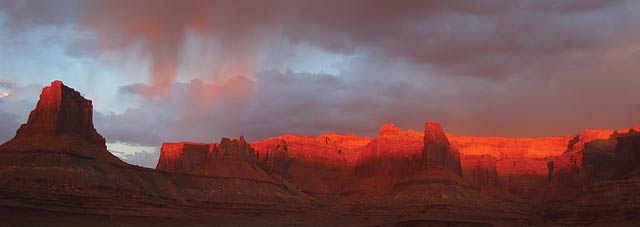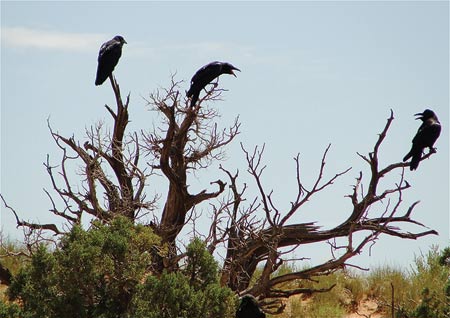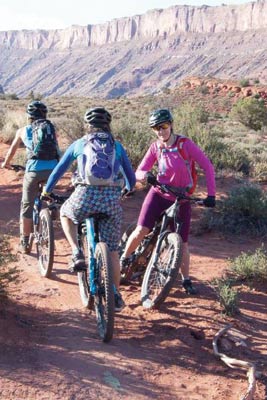|
|
Cycling HAPPENINGS October 2018
|

Article courtesy of Rim Tours Mountain Bike Adventures 1233 S. Hwy 191, 435-259-5223 |
|

Planning to spend a week or a day visiting Canyon Country? Here are a few simple rules about how to play in this mostly unspoiled natural paradise without ruining it for those who will come after you. (It’ll also make your own visit an even richer experience!)
Prepare In Advance
- Know the regulations and special concerns for the area you'll visit.
- Prepare for extreme weather, hazards, and emergencies.
- Schedule your trip to avoid times of high use.
- Visit in small groups when possible. Consider splitting larger groups into smaller groups.
- Repackage food to minimize waste.
- Use a map and compass.
If You Find Something Cool, Leave It Where It Is
- Preserve the past: examine, but do not touch cultural or historic structures and artifacts.
- Leave rocks, plants and other natural objects as you find them.
- Avoid introducing or transporting non-native species.
- Do not build structures, furniture, or dig trenches.

Courtesy National Park Service
Let The Wildlife Be Wild (Leave Them Alone)
- Observe wildlife from a distance. Do not follow or approach them.
- Never feed animals. Feeding wildlife damages their health, alters natural behaviors, and exposes them to predators and other dangers.
- Protect wildlife and your food by storing rations and trash securely.
- Control pets at all times, or leave them at home.
- Avoid wildlife during sensitive times: mating, nesting, raising young, or winter.
Pay special attention to:
- Biological Crust (it’s everywhere, and it’s delicate! Educate yourself about how to recognize it, and don’t step on it.)
- Potholes (even if completely dry, there are often living creatures lying dormant in the dirt at the bottom, awaiting the next rainstorm. Please don’t disturb them.)
 |
Courtesy Moab Trail Mix |
Do Unto Others…
- Respect other visitors and protect the quality of their experience.
- Be courteous. Yield to other users on the trail.
- Special Note for E-bikes:
- All e-bikes are considered motorized vehicles. Many of the singletrack trails in Moab were built utilizing state funding sources which specify that the resulting trails be used specifically for non-motorized recreation. E-bikes may not be used on Moab area trails marked as non-motorized. E-bikes are welcome on the many motorized trails available.
- While riding an e-bike, yield to all non-motorized riders, hikers and equestrians you encounter.
- Always yield to equestrians by stepping to the downhill side of the trail when you encounter them.
- Let nature's sounds and silence prevail. Avoid loud voices and noises.
Deal With It (Don’t Leave It for Others to Deal With)
- Pack it in, pack it out. Inspect your campsite and rest areas for trash or spilled foods. Pack out all trash, leftover food and litter.
- Deposit solid human waste in cat-holes dug 6 to 8 inches deep, at least 200 feet from water, camp and trails. Cover and disguise the cat-hole when finished or better yet, bring a portable toilet/wag bag.
- Pack out toilet paper and hygiene products.
- To wash yourself or your dishes, carry water 200 feet away from streams or lakes and use small amounts of biodegradable soap. Scatter strained dishwater.
- Don’t wash your hair in a stream.
Find the Least Destructive Path
- Stay on the trail.
- Restrict travel to durable surfaces including established trails and campsites, rock, gravel or sand, dry grasses or snow.
- Protect riparian areas by camping at least 200 feet from lakes and streams.
- Good campsites are found, not made. Altering a site is not necessary.
In popular areas:
- Restrict use to existing trails and campsites.
- Walk single file in the middle of the trail, even when wet or muddy.
- Keep campsites small. Focus activity in areas where vegetation is absent.
In pristine areas:
- Disperse use to prevent the creation of campsites and trails, sweep out tracks where possible near roads or existing trails.
- Avoid places where impacts are just beginning.
Use Fire Sparingly, And Wisely
- Campfires can cause lasting impacts to the backcountry. Heed all fire restrictions and don’t start a campfire in windy conditions.
- Use a lightweight stove for cooking and enjoy a candle or lantern for light.
- Where fires are permitted, use established fire rings, fire pans, or mound fires, and bring your own wood – do not collect deadwood.
- Keep fires small. Only use sticks from the ground that can be broken by hand.
- Burn all wood and coals to ash, put out campfires completely, then carry ashes out with your trash.
- Dead looking trees are an important part of the desert ecosystem. Leave it alone – do not collect for firewood.
When In Doubt, Ask A Local, or Hire A Guide
For more information, visit the Leave No Trace Program website.
|
|
|
|
|
|
© 2002-2024 Moab Happenings. All rights
reserved.
Reproduction of information contained in this site is
expressly prohibited.
|
|



